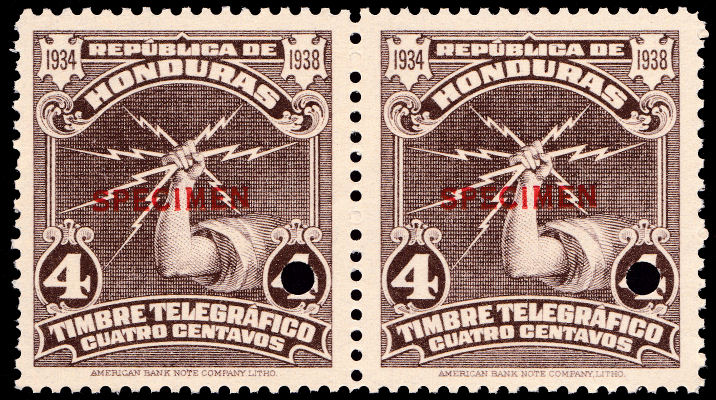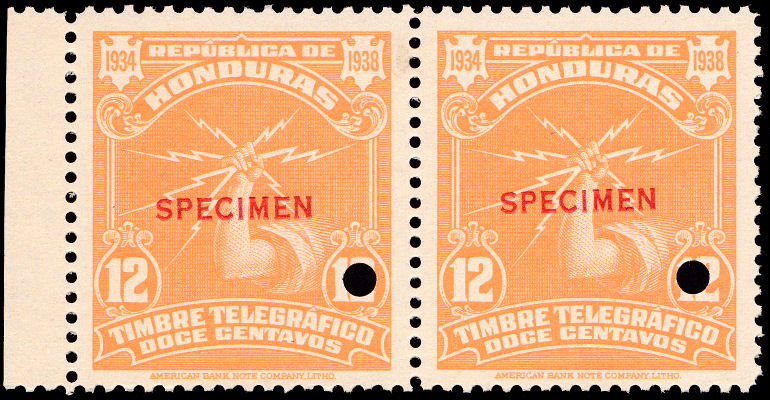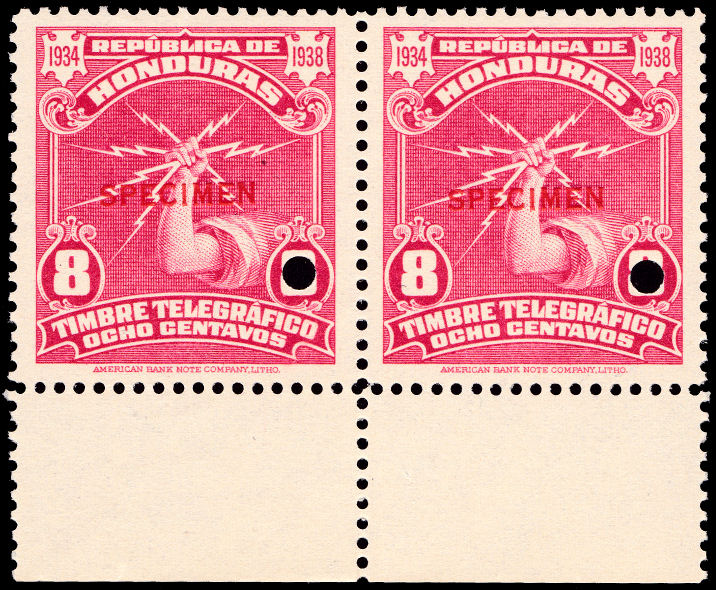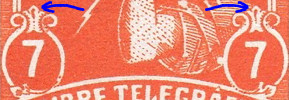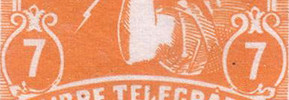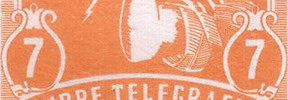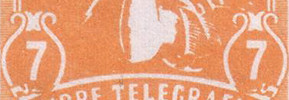| Up a level | ||||||||||
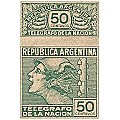 |
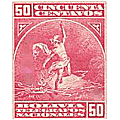 |
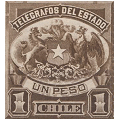 |
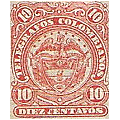 |
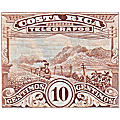 |
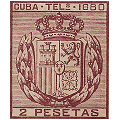 |
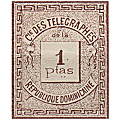 |
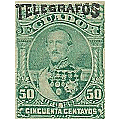 |
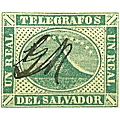 |
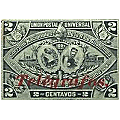 |
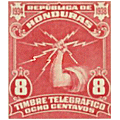 |
| Argentina | Bolivia | Chile | Colombia | Costa Rica | Cuba | Dominican Rep. | Ecuador | El Salvador | Guatemala | Honduras |
| Up a level | ||||||||||
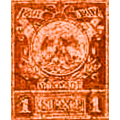 |
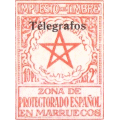 |
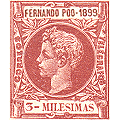 |
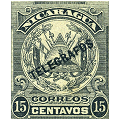 |
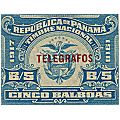 |
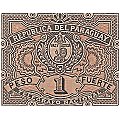 |
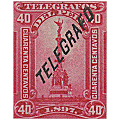 |
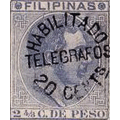 |
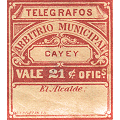 |
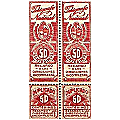 |
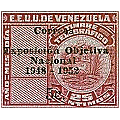 |
| Mexico | Morocco | Guinea | Nicaragua | Panama | Paraguay | Peru | Philippines | Puerto Rico | Uruguay | Venezuela |
I have completely revised Hiscocks' original listing, though leaving references to the original designations. There were only the 1934 (A.B.N. Co.) originally listed. I have brought these prices up to date and added currency selection. The new designations have 'RH' numbers (Revised Hiscocks) to avoid confusion. I have added prices for the new additions. However the prices are very much guesswork as there are few on the market. These will probably need to be re-numbered as more are reported. CheckList Setup |
Honduras.
Steve Hiscocks wrote:
The three values of Honduras exist in two forms — with and without a "control mark" consisting of an indecipherable scribble in purple said to
represent the signature of one J.M. Lopez. Although N.F. Seebeck (see introduction to Ecuador section) did have a contract with the Honduras Government
from 1890 to 1895 he seems not to have turned his attention to telegraph stamps.
My notes:
Steve Hiscocks touched only the tip of the iceberg with this. Many more have been added and there may yet be more to add.
Telegraphy in Honduras began in 1876 with a connection between La Paz and Comayagua. Tegucigalpa was added in 1877,
and later that year, Comayagua was connected to San Salvador.
In 1879, connections were made to Guatemala and Nicaragua, and in 1880 the San Pedro Sula and the San Antonio del Norte offices were added.
This progress owed a lot to Dr Marco Aurelio Soto. Lists of 1906 and 1908 for wireless-Telegraph stations lists nothing in Honduras. Similar lists for both 1910
and 1912 give Ceiba and Swan Island (Islas Santanilla) about 153 kilometres (95 miles) off the northeast coast, then with a United Fruit Co. coconut plantation.
Ceiba had a railway used by the Standard Fruit Co. to gather bananas from their plantations there.
Nearby Tela had a separate railway used by the United Fruit Co. to gather bananas from their plantations.
Apparently the Honduran Government contracted in 1877 with a businessman by the name of J. A. Braam to install a submarine telegraph cable
between Puerto Cortés and Cabo San Antonio in Cuba to gain access to the USA, but I have seen no evidence of this happening.
The telephone service began in 1891, and became automatic in 1932 with a 1,000-line telephone exchange in Tegucigalpa.
In 1921 the Tropical Radio Telegraph Company, obtained a concession from the Government of Honduras for 50 years,
giving it an absolute monopoly over radio-communications in Honduras.
As regards N. F. Seebeck, Honduras cancelled their contract with him 26 November 1893. otherwise things may have been different.
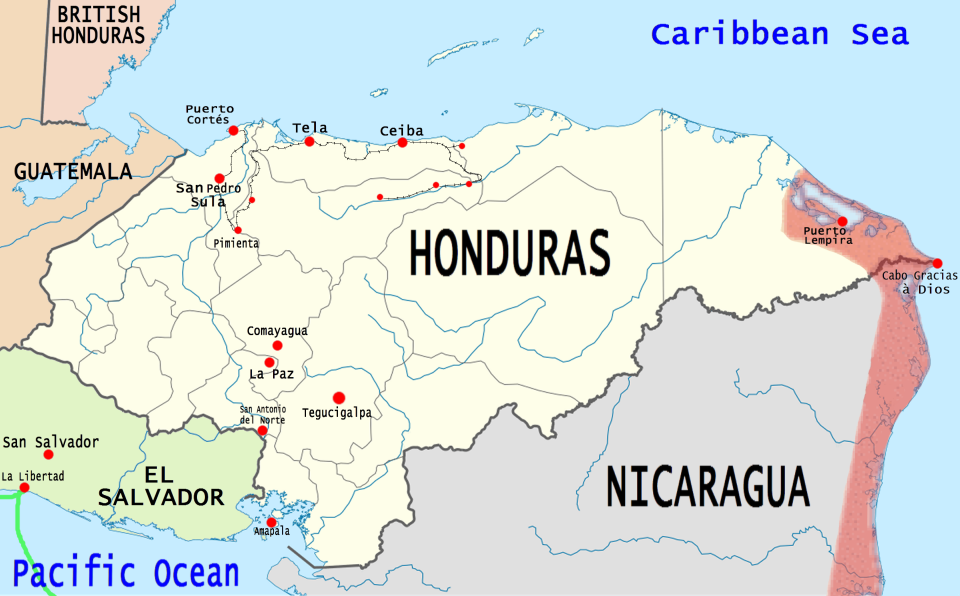
Map of Honduras showing Telegraph stations. By 1880 there was a connection from Tegucigalpa through to San Pedro Sula.
The pink area shows the approximate boundaries of the Kingdom of Miskito which
was an Autonomous territory of Nicaragua from 1860 to 1894, when it became part of Nicaragua.
The part in what is now Honduras, did not become part of Honduras until 1960.
A submarine cable connection at La Libertad in El Salvador linked between San Juan del Sur, Nicaragua to the south and Mexico to the north.
Enigma?
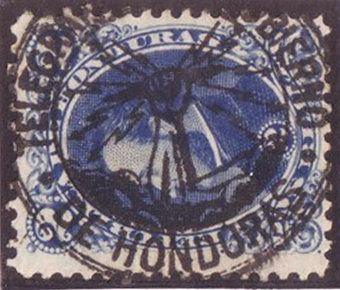
This 2r stamp, courtesy of Rolf Lamprecht, is listed by Scott as issued in 1878 by the National Bank Note Co. of N.Y. in deep blue on thin, hard paper,
and re-issued in 1889 as ultramarine on soft paper, printed by American Bank Note Co. of N.Y.
The 1889 reissue was part of the contract between the Honduran Government and N. F. Seebeck, signed on 20 April 1889.
Section 11 required Seebeck to receive the leftover stock of the previous year and to reprint as many as needed for collectors.
Though they were printed by the American Bank Note Company, Seebeck paid for it. He would then have received the remainders when supplying the 1890 issue of postage stamps.
For the initial issue, the Scott catalogue says that various counterfeit cancellations exist and most used copies are the reissued ones with fake or favour cancels.
For the 1889 re-issue, which they only price for mint, they say they were "not intended for postal use", it says they were valid and genuine cancels are known.
What it does not say is what they were intended for. Chapter 6 of Seebeck: Hero or Villain? says they were sent to Honduras at the end of 1889.
The 1890 issue was on 6 January.
If this is genuine telegraphic usage then this is indeed a nice find, but Seebeck is known to have neatly cancelled many Ecuadoran telegraph stamps for collectors, so it seems doubtful.
Image from RL. - Does anyone have more images ?
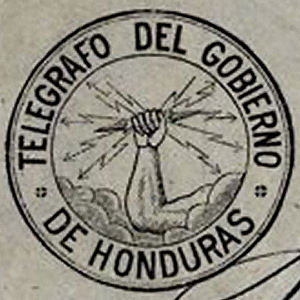
The 'Seal' from a telegram of 1890 shown below. This compares well with the cancel on the stamp above.
Image courtesy of HondurasStamps.com
1915? Postage stamps. Perf. 11½
 |
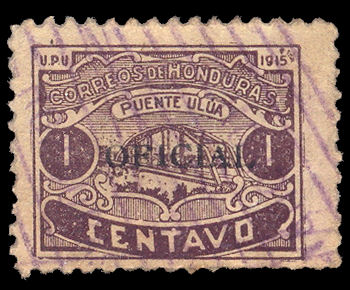 |
| 1915 UPU Postage stamps. Other values are 10c, 20c, 50c, 1p — Images courtesy of Rolf Lamprecht. | Official overprint, the set was overprinted in red or black - courtesy of Rolf Lamprecht. |
Two types of overprints were applied to these for use with Cablegrams.
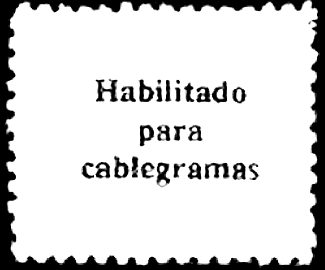 |
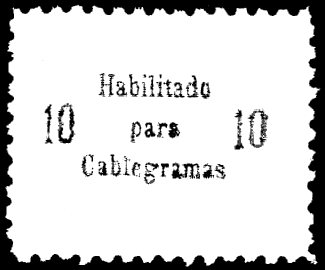 |
| Type 1 "Habilitado para Cablegramas". | Type 2 10 "Habilitado para Cablegramas" 10 |
1917? Postage stamps overprinted "Habilitado para Cablegramas".
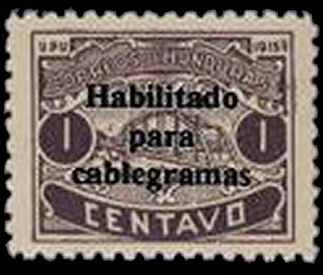
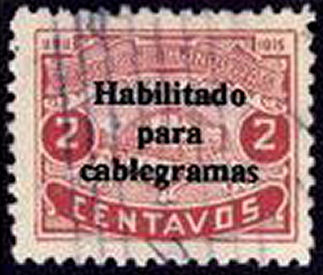 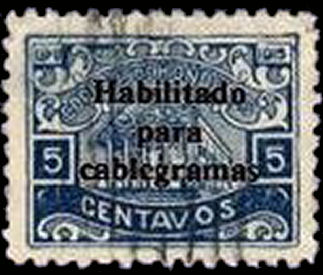
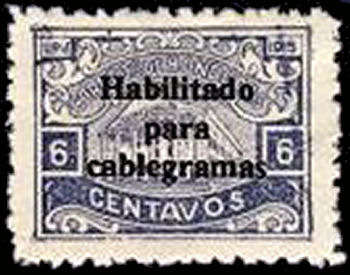
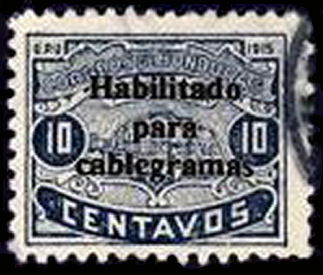
|
| RH1 - RH5, with Type 1 overprint The status of these stamps is uncertain. — Images courtesy of Craig A.. |
1918? Postage stamps overprinted "Habilitado para Cablegramas" and surcharged 10c. Perf. 11½
 |
| RH6 - RH9, with Type 2 overprint The status of these stamps is uncertain. — Images courtesy of Victor Gugliano. |
John Barefoot questions the status of these, pointing out that they have only appeared on the market recently and only exist mint.
Whilst that is true, the same applies to many other stamps of Honduras and also the Dominican Republic.
Normal procedures in telegraphy generally destroy used stamps.
A US Wireless-Telegraph station list for 1906 showed nothing for Honduras.
A similar list for
1910 mentions Ceiba with no details and a commercial installation on Swan Island.
Part of the largest island of the Swan Island group was leased to the United Fruit Company for a time, but it's about 150km from shore.
However, by 1912 the port of Ceiba had three fruit companies including United Fruit, with banana plantations, all American owned.
In 1913 United Fruit Co. established two Railroad Companies and came to dominate the Honduran banana industry.
It is quite possible that United Fruit Co. provided these stamps to growers along their rail network to advise when cargoes were ready.
United Fruit Co. provided their own franks for this very purpose until at least 1913. Perhaps with a monopoly they started charging !
I do find it strange though that they should use the four lowest face values, all overprinted with 10 cents. Colour coding ?
Perhaps it aligned to the practice with their own franks of changing the colour each year.
| RH # | Hisc. | Type. | Description | Mint | Used |
|---|---|---|---|---|---|
| RH1 | - | 1 | 1c purple-brown | - | - |
| RH2 | - | 1 | 2c rose | - | - |
| RH3 | - | 1 | 5c blue | - | - |
| RH4 | - | 1 | 6c violet | - | - |
| RH5 | - | 1 | 10c dark blue | - | - |
| RH6 | - | 2 | 10c on 1c purple-brown | - | - |
| RH7 | - | 2 | 10c on 2c rose | - | - |
| RH8 | - | 2 | 10c on 5c blue | - | - |
| RH9 | - | 2 | 10c on 6c violet | - | - |
1917? As above but on Official stamps.
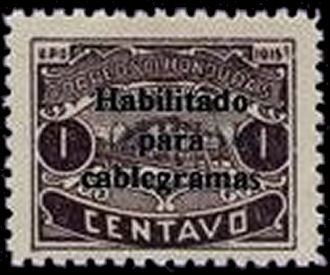
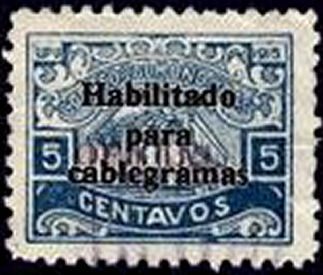
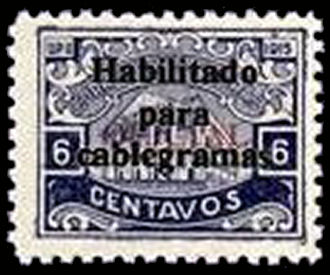
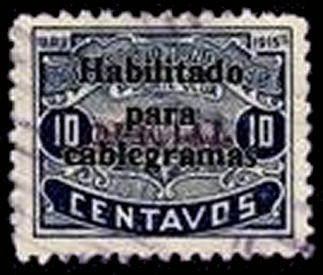
|
| RH10, RH12, RH13 and RH14, with Type 1 overprint The status of these stamps is uncertain. — Images courtesy of Craig A.. |
1918? As above but with 10c surcharge.
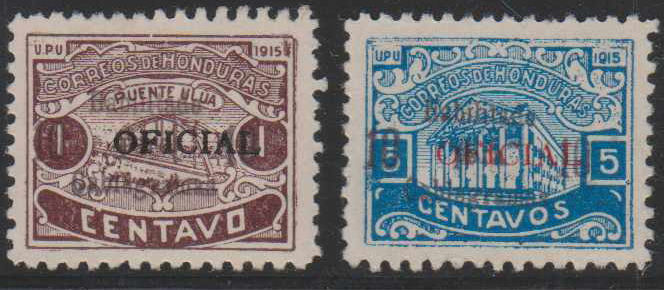 |
| RH15 and RH16. The status of these stamps is also uncertain. It is likely that more of this set exist. Images courtesy of Victor Gugliano. |
| RH # | Hisc. | Type. | Description | Mint | Used |
|---|---|---|---|---|---|
| RH10 | - | 1 | 1c purple-brown (Black) | - | - |
| RH11 | - | 1 | 2c rose (Black ?) | - | - |
| RH12 | - | 1 | 5c blue (R) | - | - |
| RH13 | - | 1 | 6c violet (R) | - | - |
| RH14 | - | 1 | 10c dark blue (R) | - | - |
| RH15 | - | 2 | 10c on 1c purple-brown (Black) | - | - |
| RH16 | - | 2 | 10c on 5c blue (R) | - | - |
1934 Lithographed by the American Bank Note Co. White wove paper. No watermark. Line-Perf. 12 x 12¾ (about 11.9 x 12.8)
Dates of 1934 and 1938 in top corners.
The 'control' takes the form a facsimile of the signature of J. M. Lopez or Alfonso Gallardo in purple.
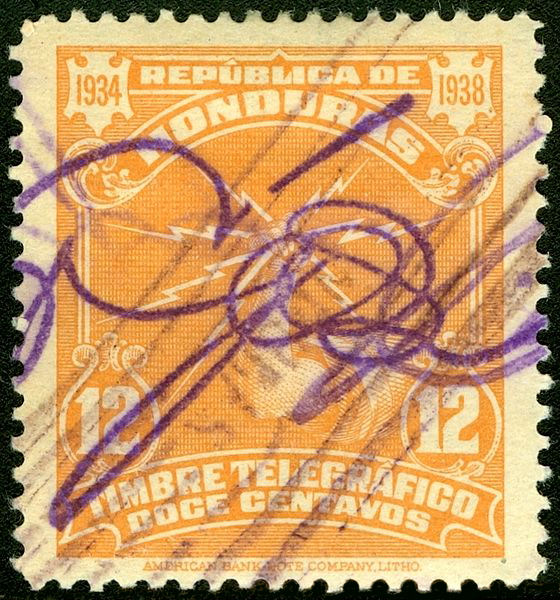 |
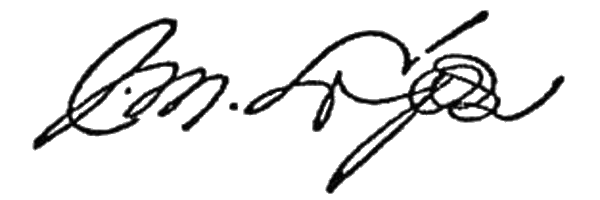 J. M. Lopez (Tegus area) 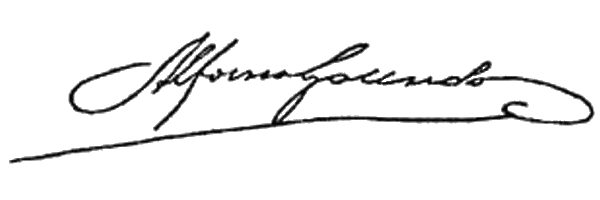 Alfonso Gallardo (Cortes department) |
| Type #1 showing a 12c used, with J. M. Lopez control mark. Image from Wikimedia Commons | Types of Controls (1933-34). These were facimile signatures hand-stamped in purple. Only these two signatures have been reported out of a possible 25! Do you unknowingly have a major rarity ? Images from HondurasStamps.com |
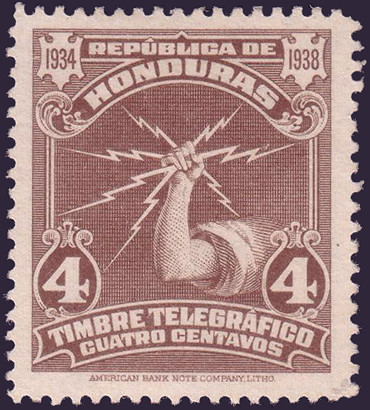
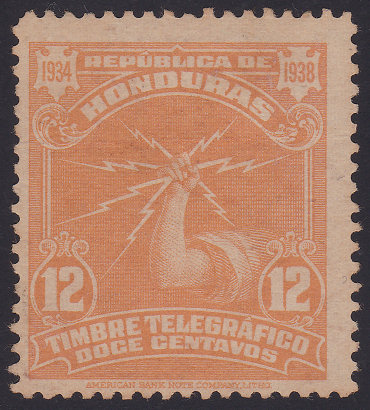
Image of RH17a (4c) is courtesy of Rolf Lamprecht and RH19a (12c). RH18b (8c) is known postally used (on cover) in March 1936.
| RH # | Hisc. | Type. | 1934 Description (A.B.N. Co.) | Mint | Used |
|---|---|---|---|---|---|
| RH17 | H1 | 1 | 4c brown (with JML control) | 7.50 | 7.50 |
| RH17a | H1a | without control | 5.00 | 5.00 | |
| RH18 | H2 | 1 | 8c scarlet (with JML control) | 7.50 | 7.50 |
| RH18a | - | with Gallardo control | 8.00 | 8.00 | |
| RH18b | H2a | without control | 5.00 | 5.00 | |
| RH19 | H3 | 1 | 12c pale orange(with JML control) | 10.00 | 10.00 |
| RH19a | H3a | without control | 10.00 | 10.00 |
Does anyone have an example of RH18a ?
Two other companies produced stamps with the same dates in the top corners. The ones above are the only ones recorded with control marks.
It is unclear when the others were printed, or which came first, but they appear to be the only ones available until 1964.
The significance of the dates is also unclear.
Date unknown. As above but lithographed by Waterlow & Sons Ltd. White wove paper. No watermark. Comb-Perf. 12½ x 13¼.
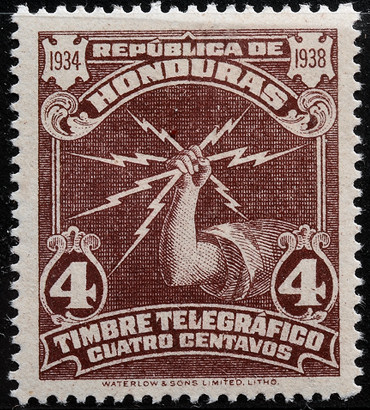 |
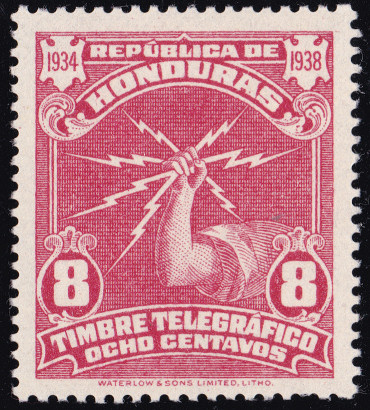 |
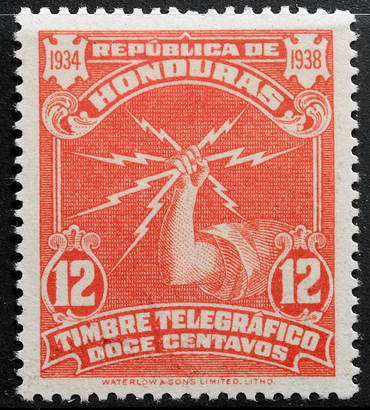 |
| Hiscocks Type 1 Printed by Waterlow & Sons Ltd. | ||
| Image courtesy of Mustafa Kocabasi. | One of mine. | Image courtesy of Mustafa Kocabasi. |
| RH # | Hisc. | Type. | Description (Waterlow) | Mint | Used |
|---|---|---|---|---|---|
| RH20 | - | 1 | 4c brown (without control) | 10.00 | 10.00 |
| RH21 | - | 1 | 8c carmine-red (without control) | 12.00 | 12.00 |
| RH22 | - | 1 | 12c orange(without control) | 15.00 | 15.00 |
Date unknown. As above but printed by the Thomas De La Rue & Co. Ltd., Litho.?
White wove paper. No watermark. Comb-Perf. 12½ x 13
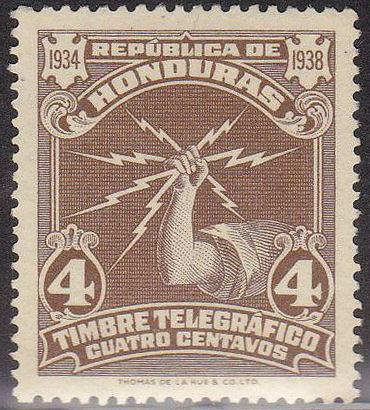
|
| Hiscocks Type 1 by Thomas De La Rue & Co. Ltd. |
| Image courtesy of Craig A. |
I do not know if other values of this type exist.
| RH # | Hisc. | Type. | Description (De La Rue) | Mint | Used |
|---|---|---|---|---|---|
| RH23 | - | 1 | 4c brown | 10.00 | 10.00 |
1964 As above but dated 1964, printed by the Thomas De La Rue & Co. Ltd., in sheets of 100 (10 x 10).
White wove paper. No watermark. Comb-Perf. 12½ x 13
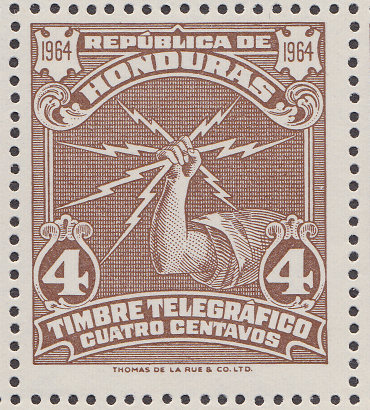
|
| Hiscocks Type 1 by Thomas De La Rue & Co. Ltd. |
I do not know if other values of this type exist.
| RH # | Hisc. | Type. | 1964 Description (De La Rue) | Mint | Used |
|---|---|---|---|---|---|
| RH24 | - | 1 | 4c brown | 10.00 | 10.00 |
1969 As above but dated 1969 and printed by the Setelipaino in Helsinki (the Security Printing House for the Bank of Finland).
Line-Perf. 14¼ x 14.
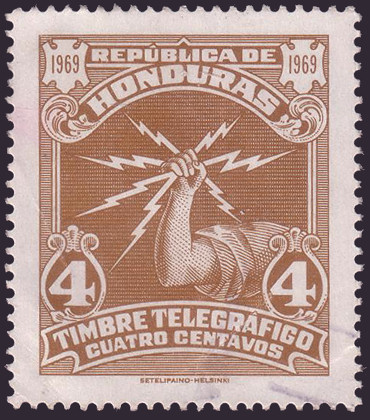 |
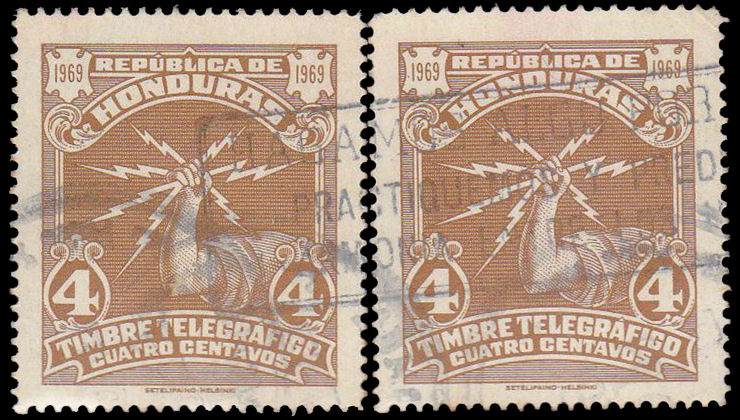 |
| Hiscocks Type 1 by Setelpaino - Helsinki. | A scarce used pair. The writing appears to be a slogan. |
| Image courtesy of Rolf Lamprecht. | Image courtesy of Craig A. |
I do not know if other values of this type exist.
| RH # | Hisc. | Type. | 1969 Description (Setelpaino) | Mint | Used |
|---|---|---|---|---|---|
| RH25 | - | 1 | 4c brown | 20.00 | 20.00 |
1972 As above but dated 1972 and no imprint, printer unknown.
White wove paper. No watermark. Line-Perf 11
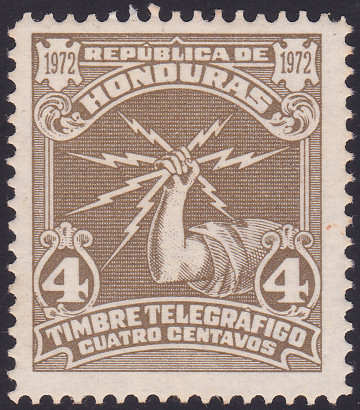
|
| Hiscocks Type 1 - 1972 |
| Mine, ex Andrew Higson. |
I do not know if other values of this type exist.
| RH # | Hisc. | Type. | 1972 Description | Mint | Used |
|---|---|---|---|---|---|
| RH26 | - | 1 | 4c brown | 10.00 | 10.00 |
| RH27 | - | 1 | 6c bright orange | 15.00 | 15.00 |
1978 As above but dated 1978.
White wove paper. No watermark. Line-Perf. 10½
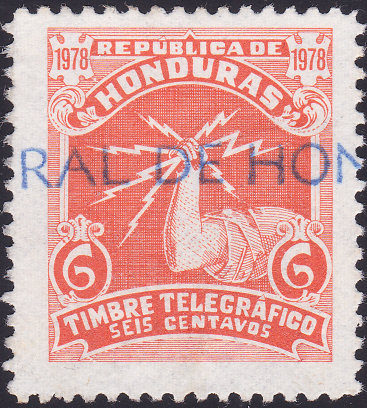 |
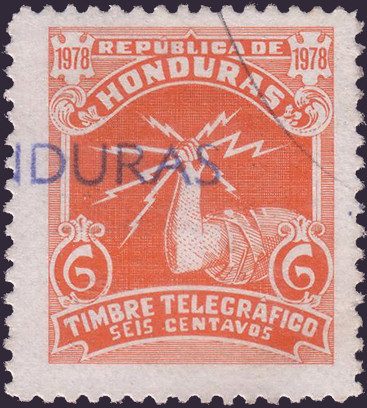 |
| Hiscocks Type 1 - 1978 (a re-united pair ?) | |
| Mine, ex Andrew Higson. | Image courtesy of Rolf Lamprecht. |
I do not know if other values of this type exist.
| RH # | Hisc. | Type. | 1978 Description | Mint | Used |
|---|---|---|---|---|---|
| RH28 | - | 1 | 6c Red-orange | 15.00 | 15.00 |
1981 No imprint. No watermark. Line-Perf. 10½ or rouletted (6½) between stamps.
John Barefoot suggests that at least the rouletted one was produced by Centro Tecnico Tipo-Litografico Nacional (CETTNA),
because that company produced the following issue.
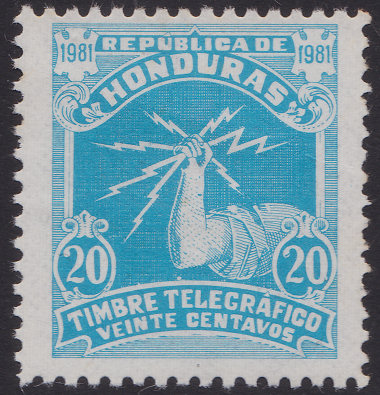 |
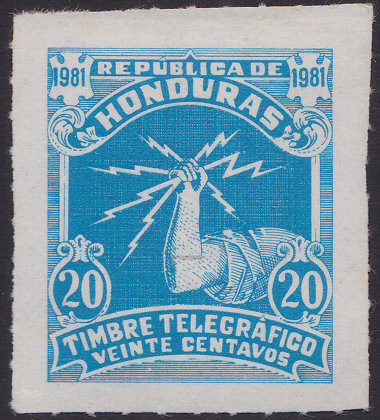 |
| 1981 20c perforated | 1981 20c rouletted |
These two were scanned together, so the shade difference is real.
I do not know if any of the other values actually exist.
| RH # | Hisc. | Type. | 1981 Description | Mint | Used |
|---|---|---|---|---|---|
| RH29 | - | 1 | 5c red | 15.00 | 15.00 |
| RH30 | - | 1 | 7c orange | 15.00 | 15.00 |
| RH31 | - | 1 | 20c light blue, perforated | 10.00 | 10.00 |
| RH31a | - | blue, rouletted | 10.00 | 10.00 |
1982 No imprint. Offset. Centro Tecnico Tipo-Litografico Nacional (CETTNA). No watermark. rouletted (6½) between stamps.
The 7c looks like a rush-job, a number of constant defects have been introduced.
There is a frame-break above 'RE' of 'REPUBLIC', a white blob on the left of the right value tablet, the left '7' is higher than the right and there is a gap between 'SIE' and 'TE'
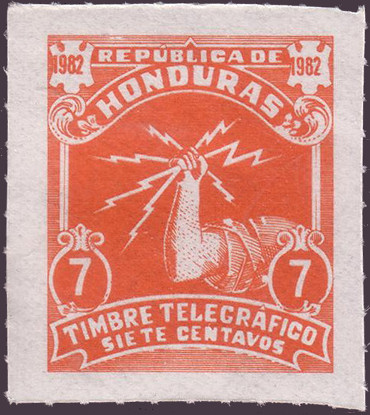 |
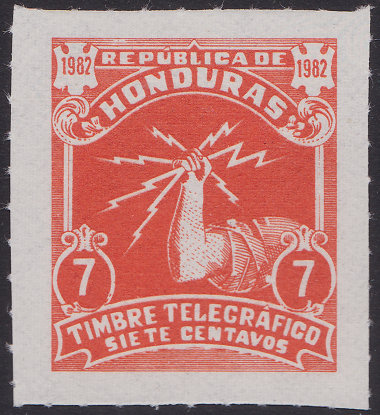 |
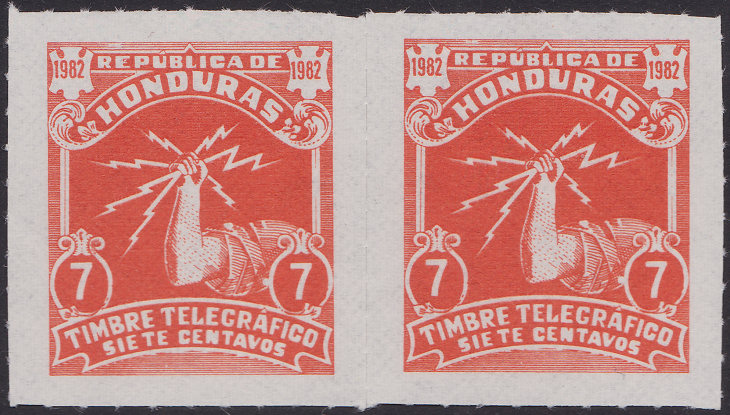 |
| 1982 7c with dates well over to the left. Image courtesy of Rolf Lamprecht. |
1982 7c single and pair showing constant flaws and variable date positions. | |
| RH # | Hisc. | Type. | 1982 Description | Mint | Used |
|---|---|---|---|---|---|
| RH32 | - | 1 | 5c Red, rouletted | 10.00 | 10.00 |
| RH33 | - | 1 | 7c Red, rouletted | 10.00 | 10.00 |
| RH33a | - | Orange | 10.00 | 10.00 |
1984 No imprint. Centro Tecnico Tipo-Litografico Nacional (CETTNA). No watermark. Rouletted 6½ between stamps.
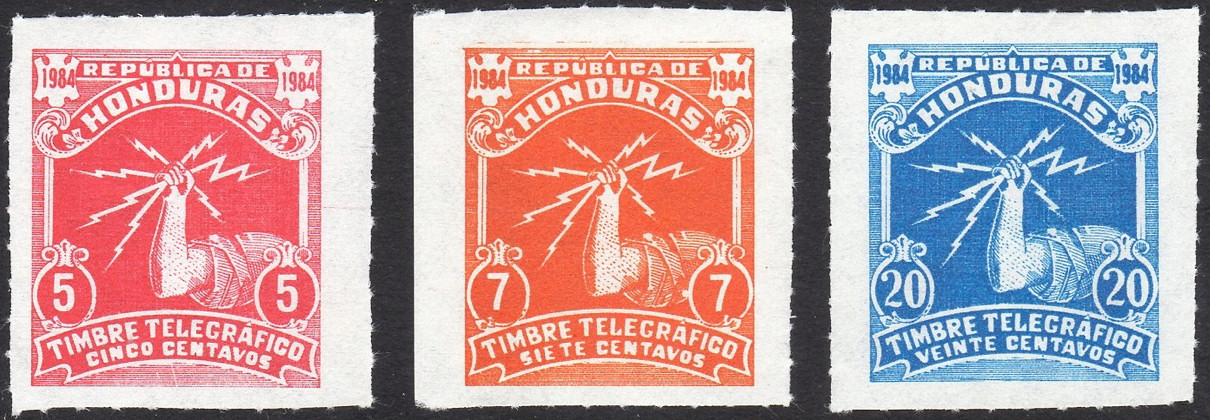 |
| 1984 Image from Wikimedia Commons - The flaws on the 7c have been duplicated from the 1982 type apart from the year. |
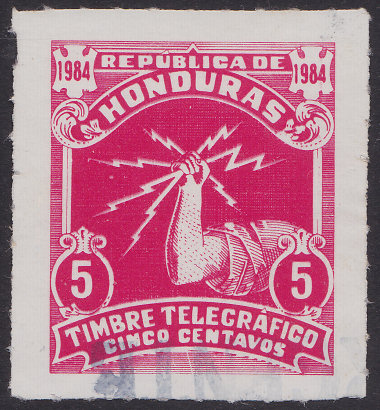 |
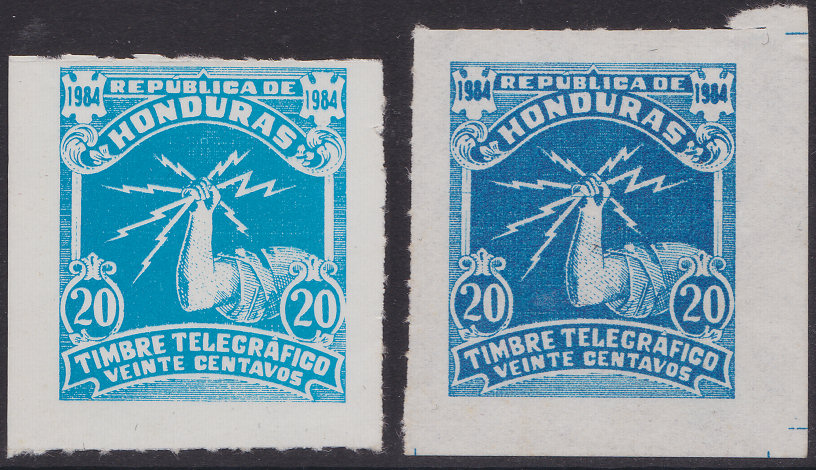 |
| 1984 5c on glazed paper. | 1984 20c shades. The corner stamp has an almost horizontal line through the fist that may be constant. |
Rolf Lamprecht has pointed out that these come in two variants, printed on matt paper or glazed paper.
The ones on matt paper are a rougher print and slightly darker shade to those on glazed paper.
On the stamps above, the 5c and light blue 20c are on shiny glazed paper.
| RH # | Hisc. | Type. | 1984 Description | Mint | Used |
|---|---|---|---|---|---|
| RH34 | - | 1 | 5c red (shades) | 12.00 | 12.00 |
| RH34a | - | Light red (glazed paper) | 10.00 | 10.00 | |
| RH35 | - | 1 | 7c orange (shades) | 12.00 | 12.00 |
| RH36 | - | 1 | 20c blue | 12.00 | 12.00 |
| RH36a | - | light blue (Glazed paper) | 10.00 | 10.00 |
Here is a 1984 20c on an envelope of 1989 (shown half scale).
This suggests there were no other 20c values printed since then.
Image courtesy of Rolf Lamprecht.
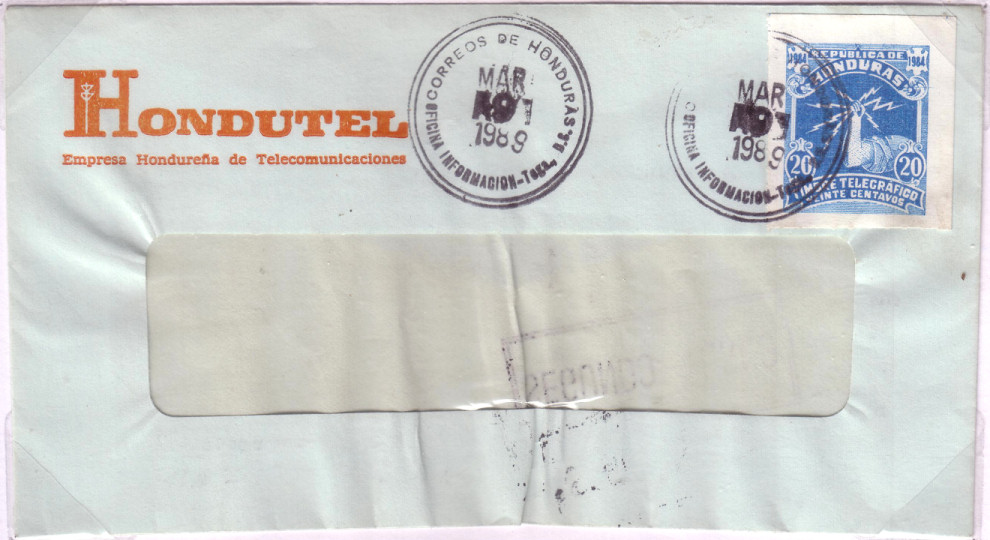
15 January 1992 Telegram (half size, as below) , with 5c and 7c of 1991, but a 20c of 1984
I cannot make any sense of the arithmetic or how it relates to the 68c in stamps, but the date matches the front.
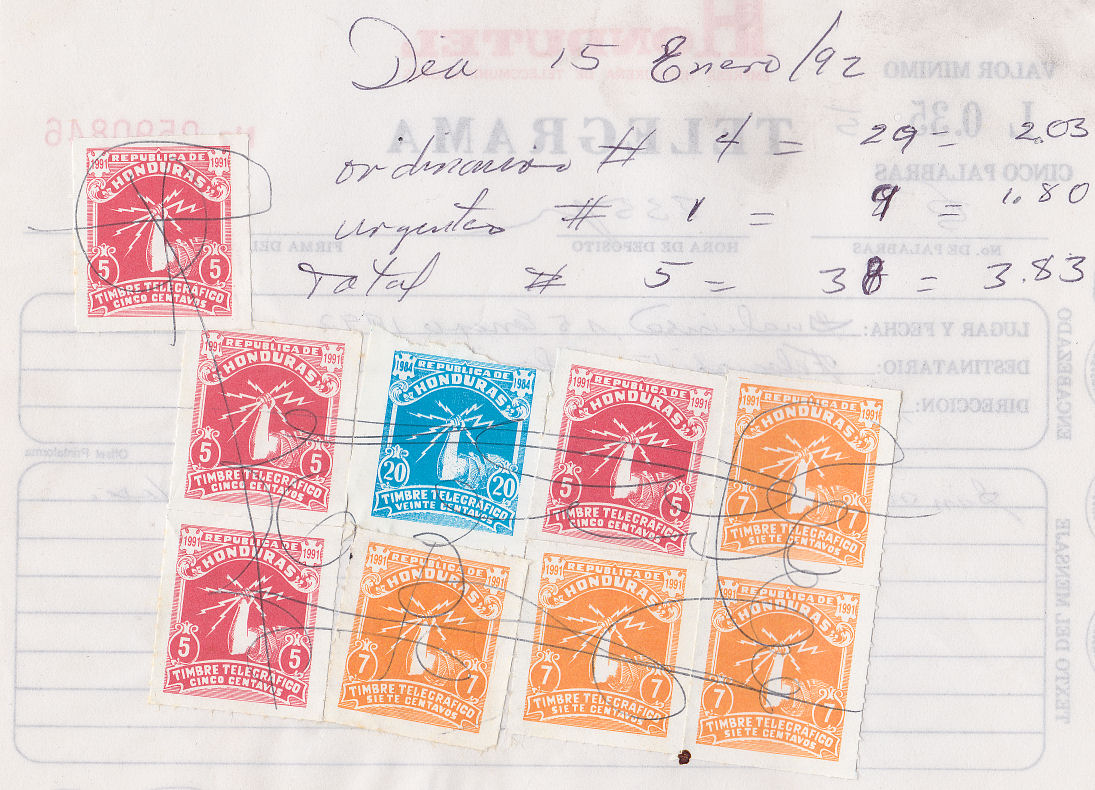
I have another piece with 20 used 1991 5c stamps on and nothing else.
This suggests that the 20c value was scarce then. A printing of the 20c value was produced later in 1991.
It also suggests that the 20c was intended for urgent telegrams.
Undated, No imprint. No watermark. Rouletted (6 ½) between stamps. Glazed paper.
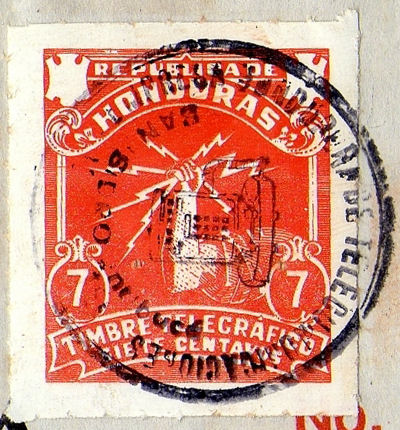 |
| 7c undated type RH26 |
| Image courtesy of Andrew Higson. |
This is on the telegram shown half scale below:
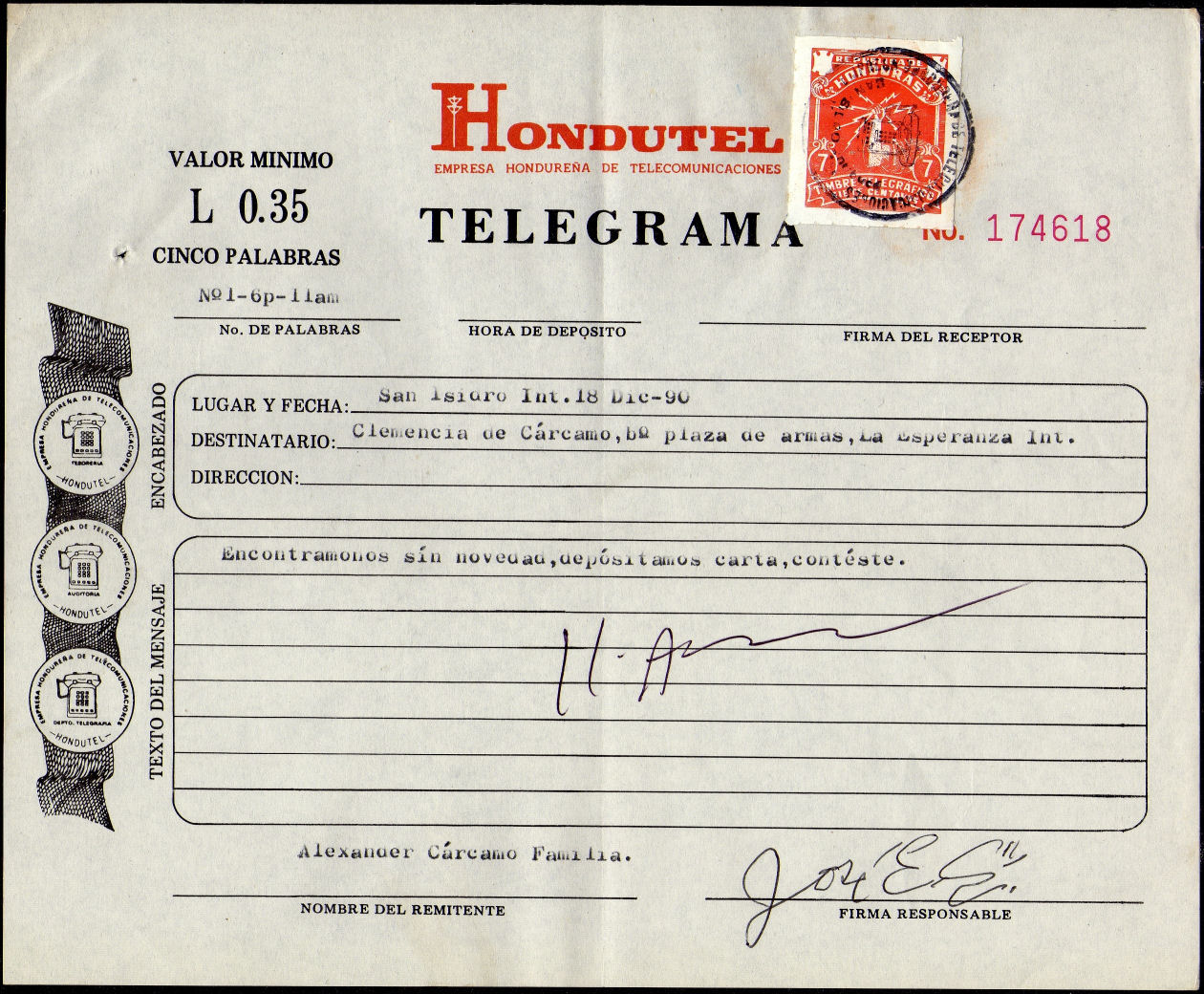
The form costs 35c for 5 words. This used 6 words, so another 7c stamp was added for the extra word. It was used in San Isidro, Intibucá.
The date ('FECHA') would seem to be 18 December 1990. I have a similar one dated 19 December 1990.
I once thought this to be a variety of the 1984 issue.
However ....
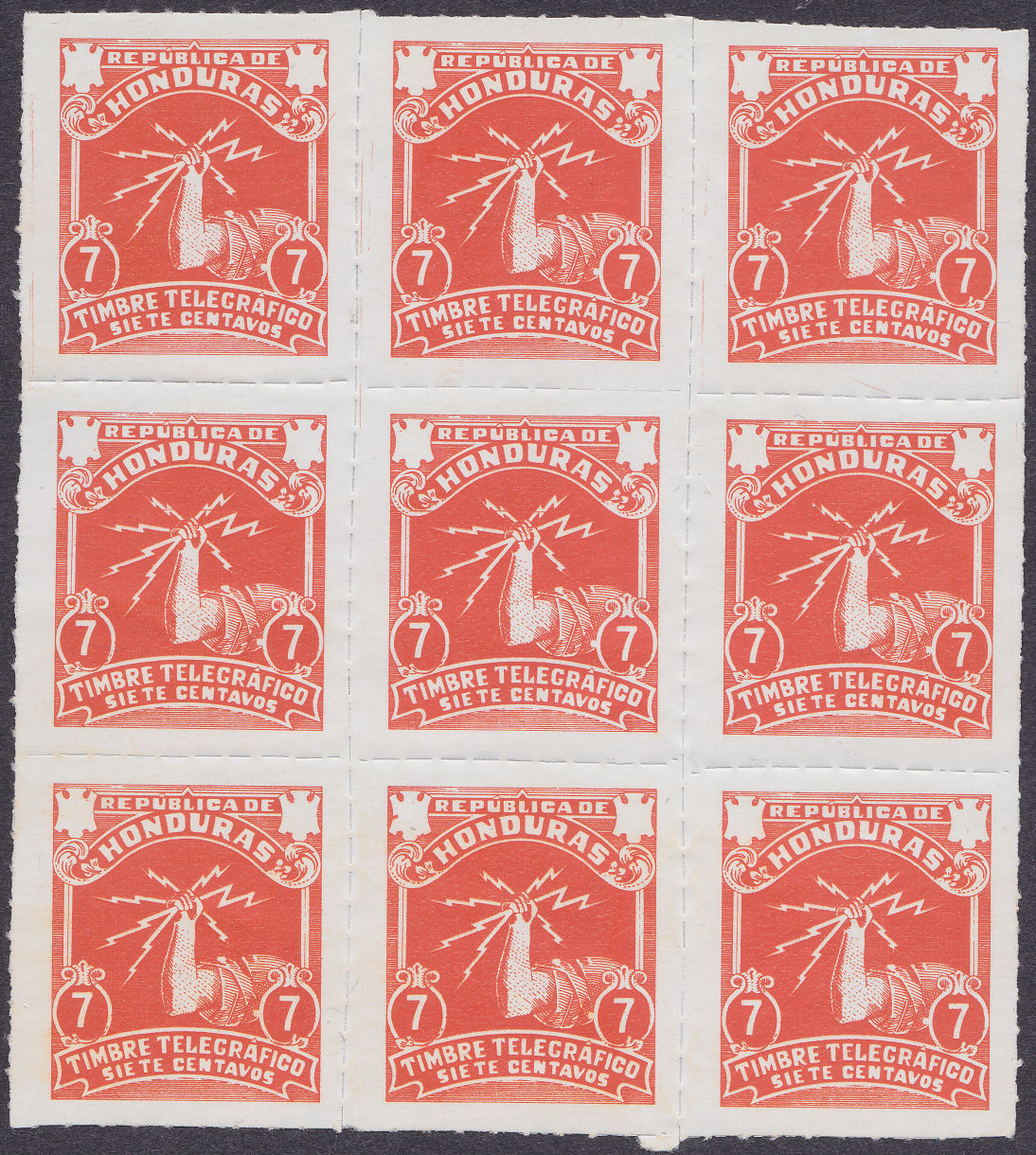
The existence of a block of 9 of them puts a whole new light on the matter.
If just the first few sheets of the 1984 issue were produced without the date on any, then corrected when it was noticed,
then I would not have thought they would still be around at the end of 1990 to use on the telegram above.
Perhaps these were a 1990 issue, and the mistake was corrected by the 1991 issue. Details though do match the 1984 issue.
Perhaps the plan was to have generic plates and add the year later, but for some reason a large undated batch was sent out.
I am told there is also a 20c blue like this, but have not seen one. This block is Ex-Andrew Higson, it is on glazed paper and is without gum.
One possible explanation is that these were produced with a two plate process, a 'key-plate' with the value and another plate with just the dates.
This could then arise if sheets were sent out that had not yet been printed on with the date plates.
It might also account for the variable position of the dates, look at the two 1984 5c stamps above.
| RH # | Hisc. | Type. | 1984? Description | Mint | Used |
|---|---|---|---|---|---|
| RH37 | - | 1 | 7c orange (shades) with missing date (see below) | 10.00 | 15.00 |
| RH38 | - | 1 | 20c blue (shades) with missing date | 20.00 | 25.00 |
1991 (3 June) No imprint. Offset by Prontaforma. (Tegucigalpa D.C.) No watermark. Rouletted (6 ½).
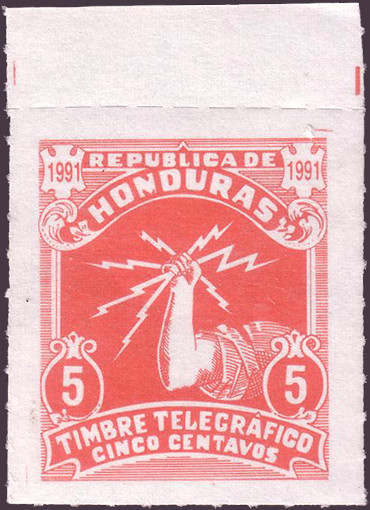 |
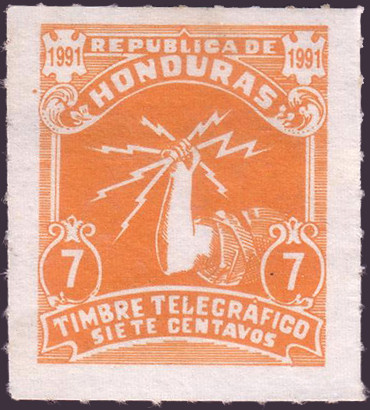 |
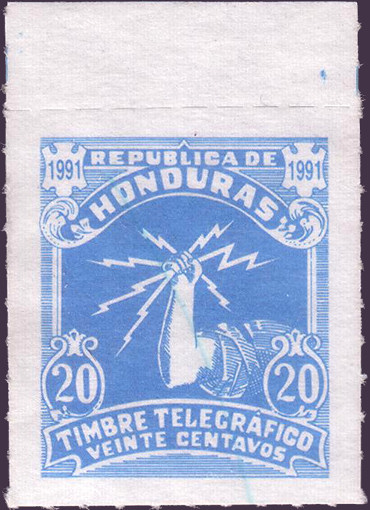 |
| 1991 - 5c | 1991 - 7c - a couple of the flaws corrected but 'SIE TE' still looks funny. |
1991 - 20c |
| Images (scanned together) courtesy of Rolf Lamprecht. | ||
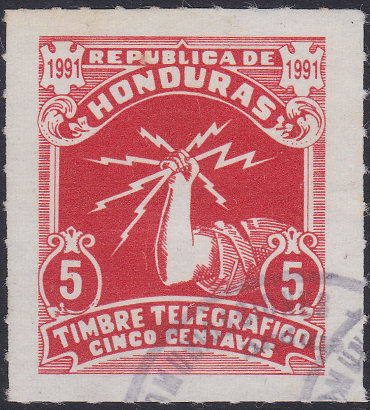 |
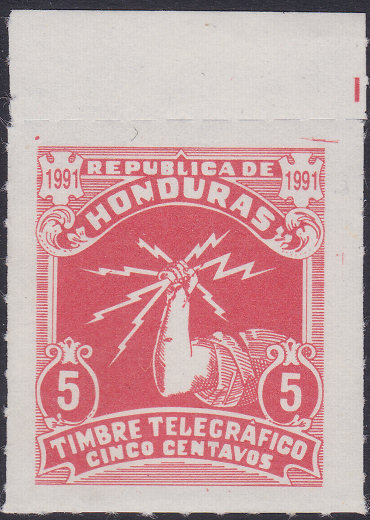 |
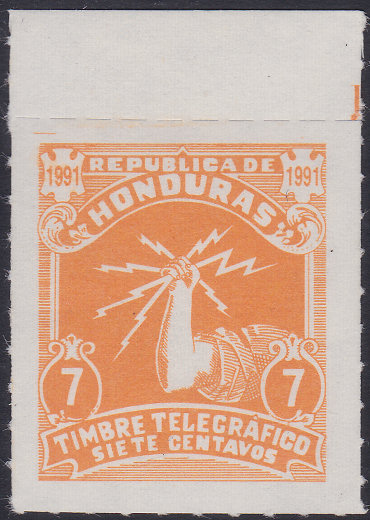 |
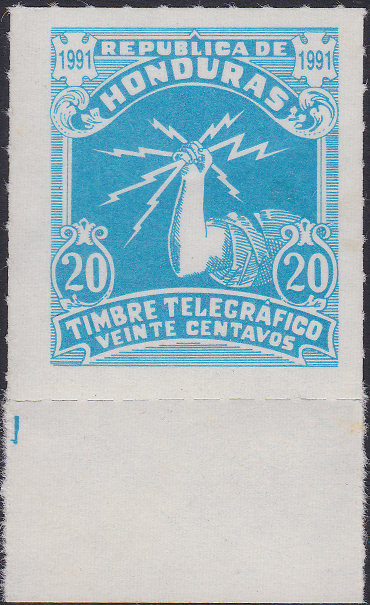 |
| 1991 a group of mine scanned together showing some shade differences. None of these are on glazed paper. | |||
| RH # | Hisc. | Type. | 1991 Description | Mint | Used |
|---|---|---|---|---|---|
| RH39 | - | 1 | 5c red | 12.00 | 12.00 |
| RH40 | - | 1 | 7c orange | 12.00 | 12.00 |
| RH41 | - | 1 | 20c blue | 12.00 | 12.00 |
1993 No imprint. Graficentro Editores (Tegucigalpa D.C.) No watermark. Rouletted (6 ½) between stamps.
These are re-drawn with some serifs gone and thin lettering for the values. 'SIETE' is now better spaced.
There are two printings with different shades and sizes as measured across the rouletting.
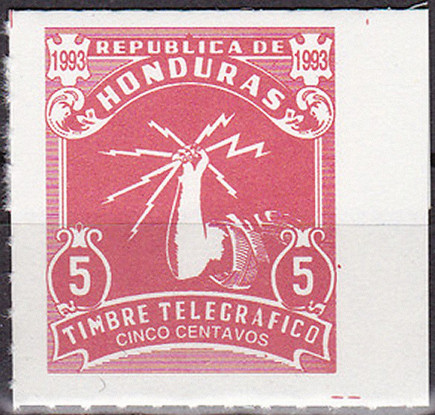 |
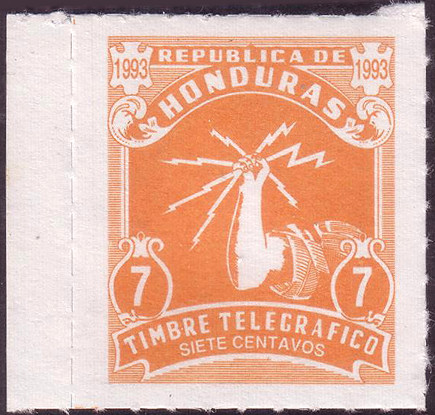 |
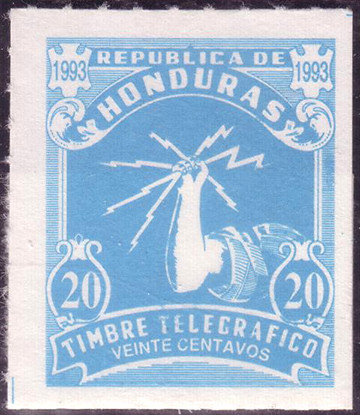 |
| 1993 5c small - from Wikimedia Commons | 1993 7c small - courtesy of Rolf Lamprecht | 1993 20c small - courtesy of Rolf Lamprecht |
The small format measure about 30.0 x 33.3 mm (1.18 x 1.31 inches) across the rouletting.
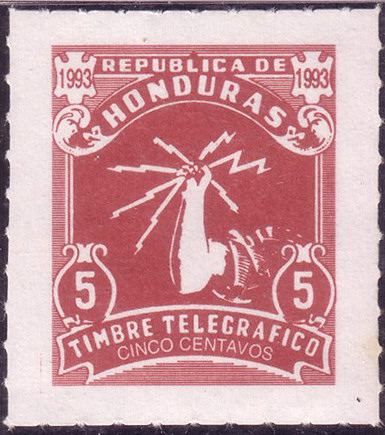 |
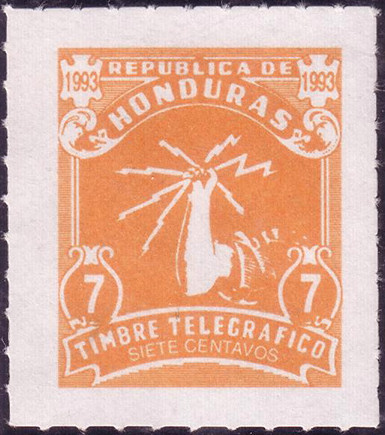 |
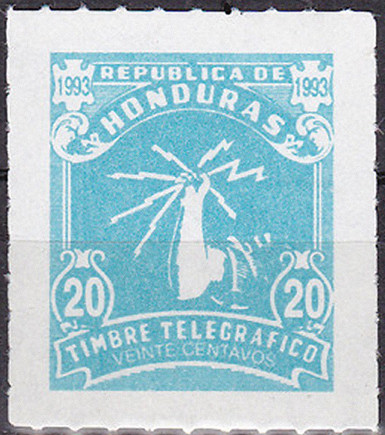 |
| 1993 5c large - courtesy of Rolf Lamprecht | 1993 7c large - courtesy of Rolf Lamprecht | 1993 20c large - from Wikimedia Commons |
The large format measure about 31.3 x 35.3 mm (1.23 x 1.39 inches) across the rouletting.
The large are a poorer quality of printing, with less detail, most noticeable on the sleeve.
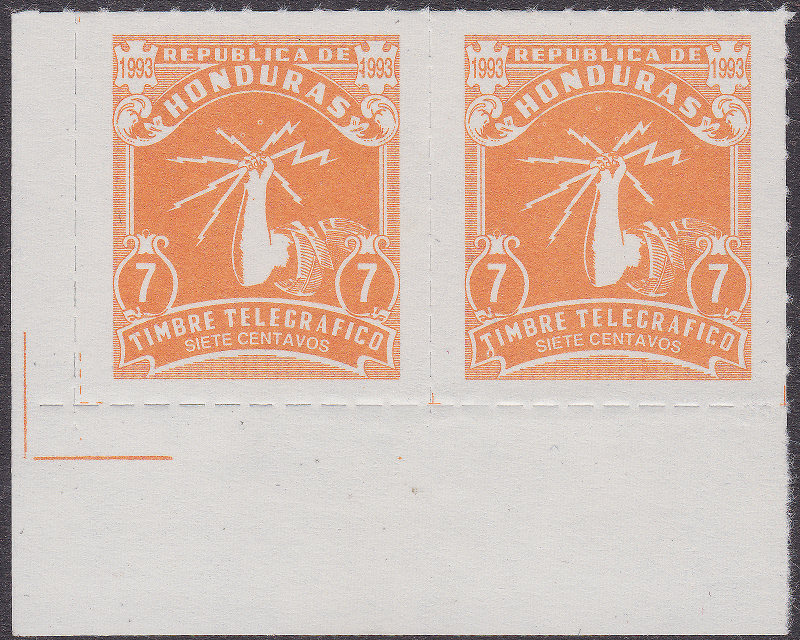
1993 - 7c small-format corner pair. - Ex Andrew Higson.
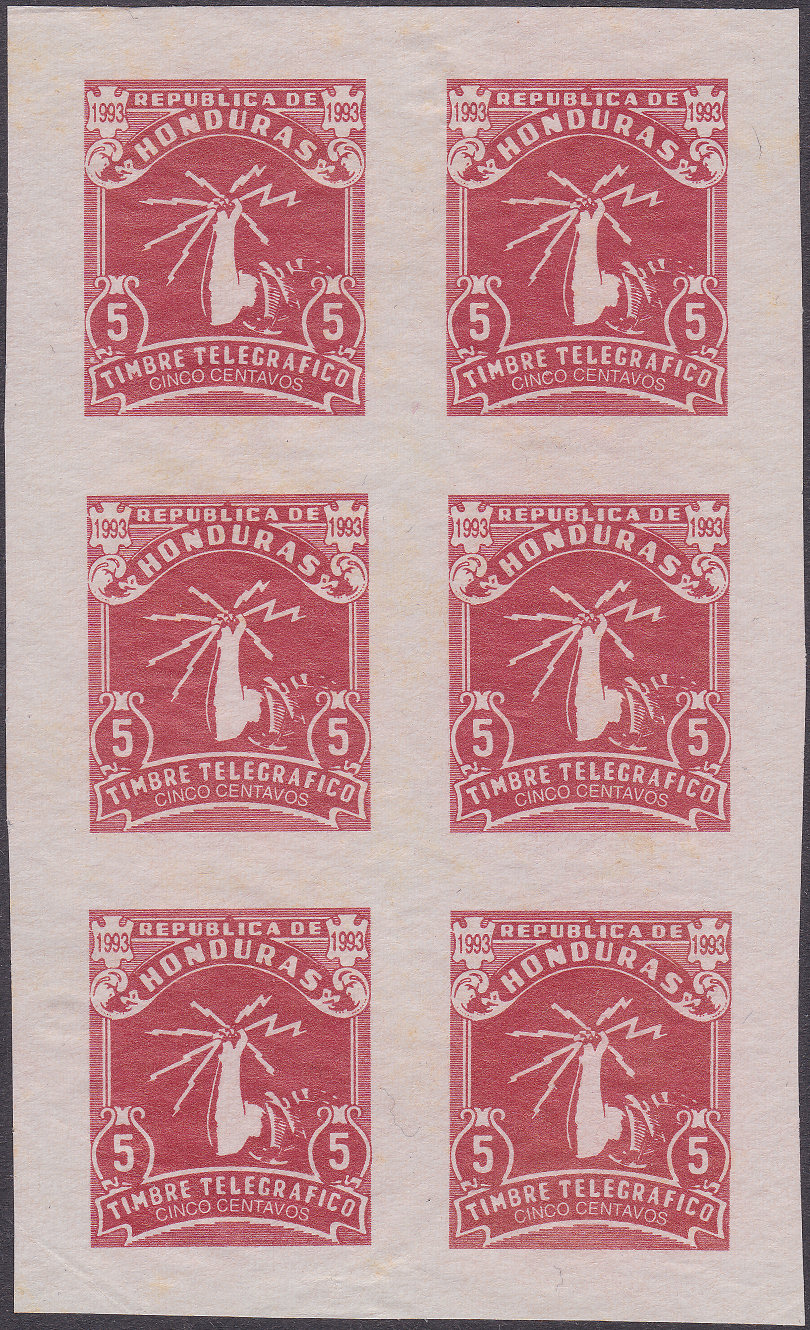
1993 - 5c imperf. block of 6 on rough paper (proof ?) - Ex Andrew Higson.
Rolf Lamprecht has a complete imperforate sheet of these. It has 7 rows of 6 stamps per row.
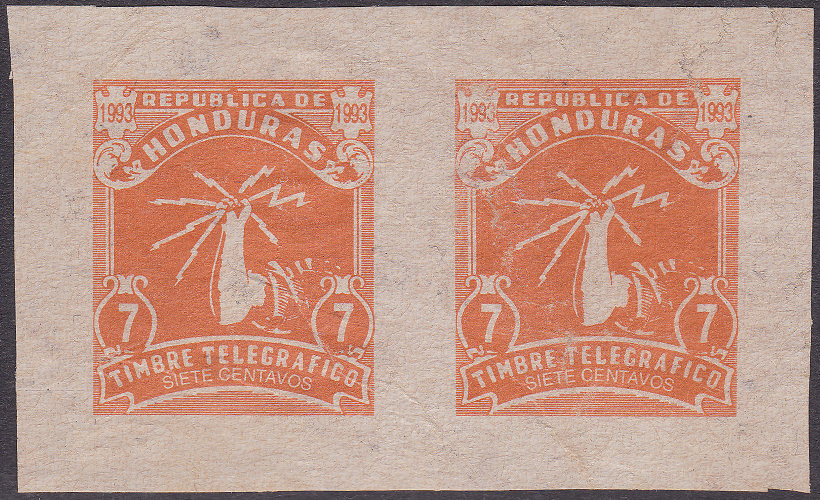
1993 - 7c imperf. pair on off-white paper (proof ?) - Ex Andrew Higson.
'SIETE' is finally fixed on this.
It is possible that other years and / or values exist.
Almost certainly these will need to be re-numbered.
Other telegrams:
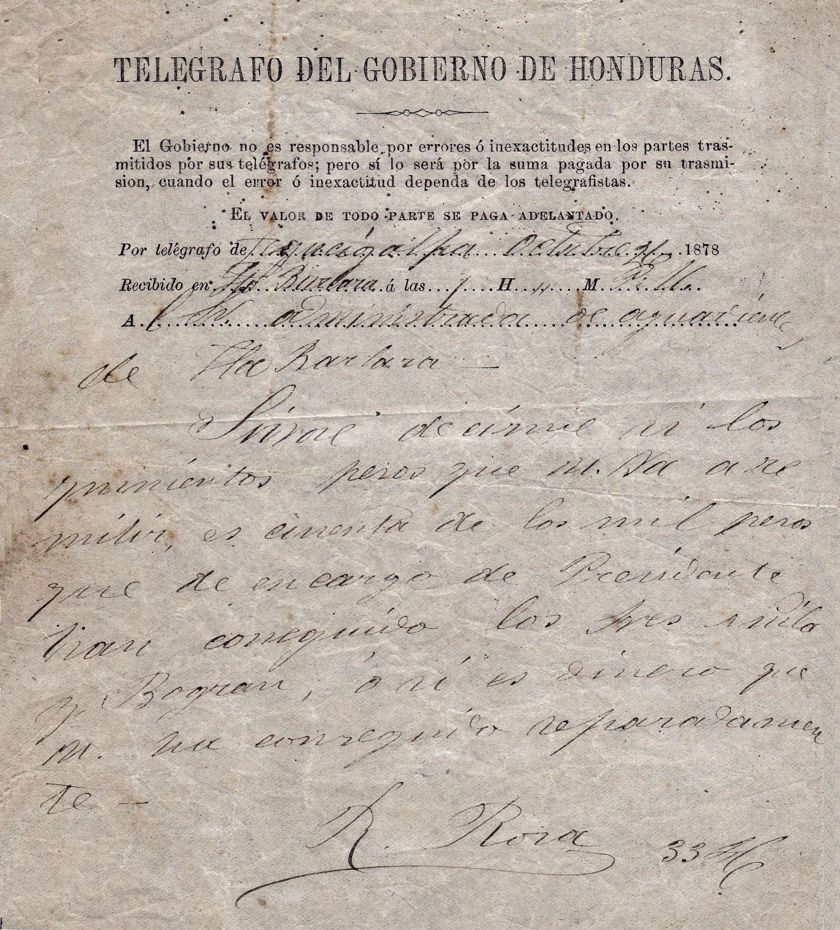
A Government Telegraph form of 26 October 1878. I see no stamps or indication of rates of charge.
Image courtesy of HondurasStamps.com
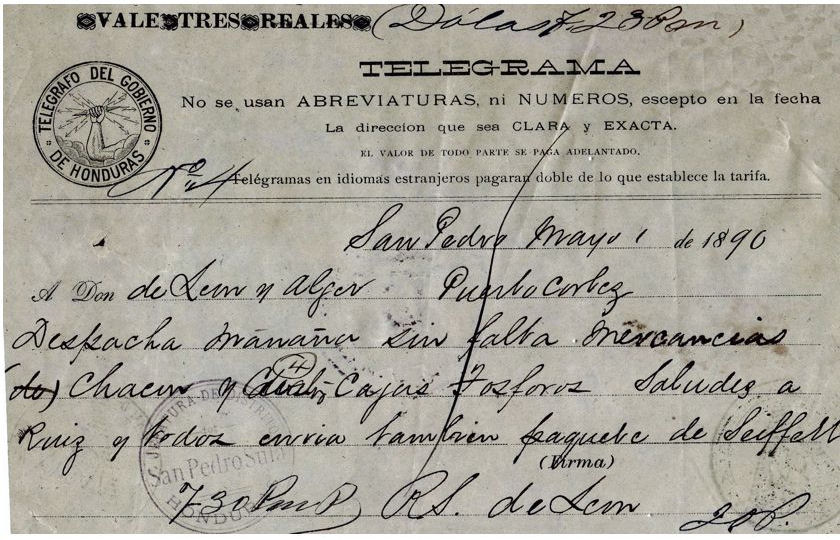
A Government Telegraph form of 1 May 1890 from San Pedro [Sula] to Puerto Cortez. I see no stamps but the form has a face value of 3 Reales.
I see no limitation on the number of words, but foreign language telegrams are double the 'established tariff'.
Image courtesy of HondurasStamps.com
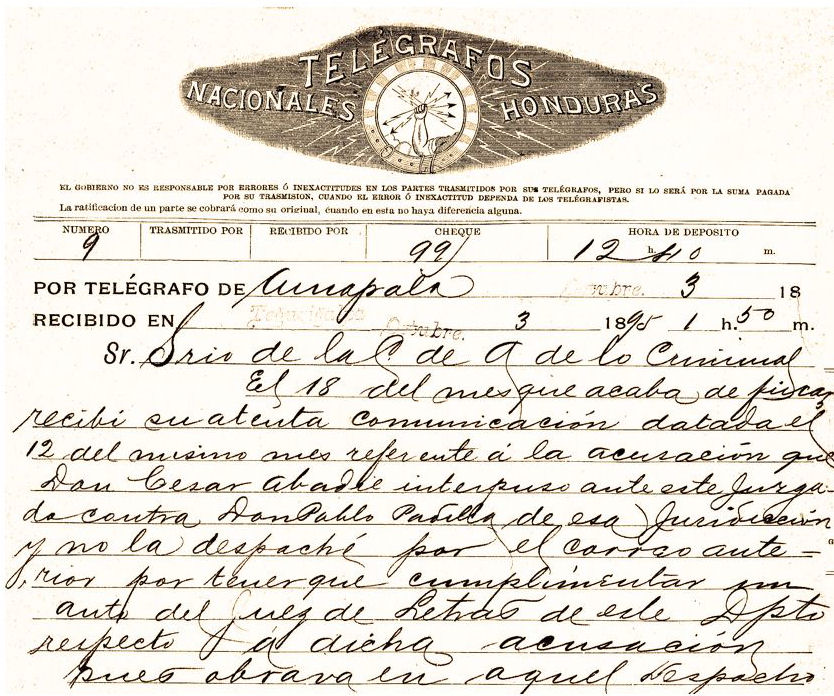
A Nacionales Telegrafos telegram received 3 October 1895 at Tegucigalpa.
Image courtesy of HondurasStamps.com
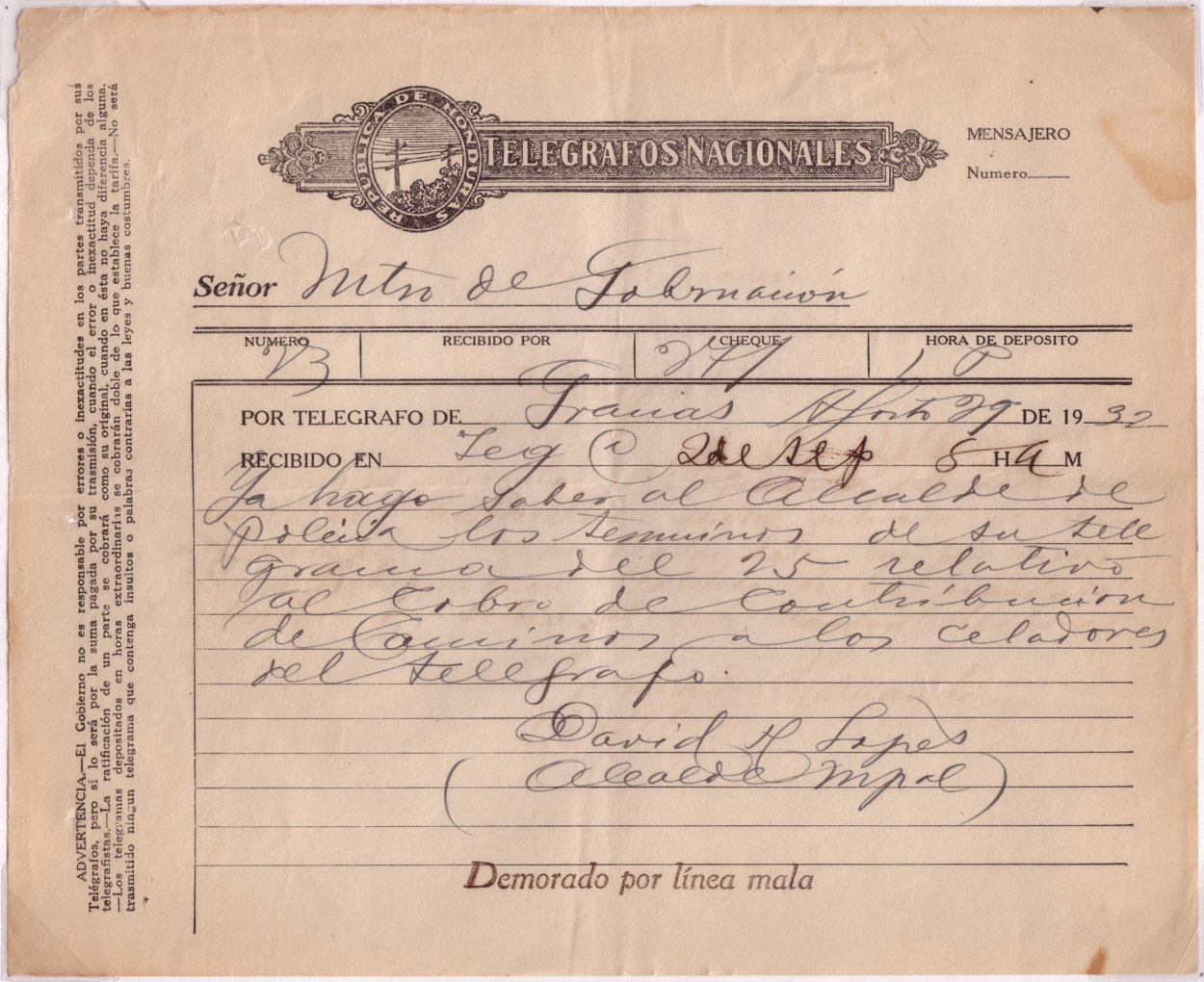
A Telegram of 29 August 1932 received at Gracias, Lempira. Image courtesy of Rolf Lamprecht.
"Demorado por linea mala" = "Delayed by bad line".
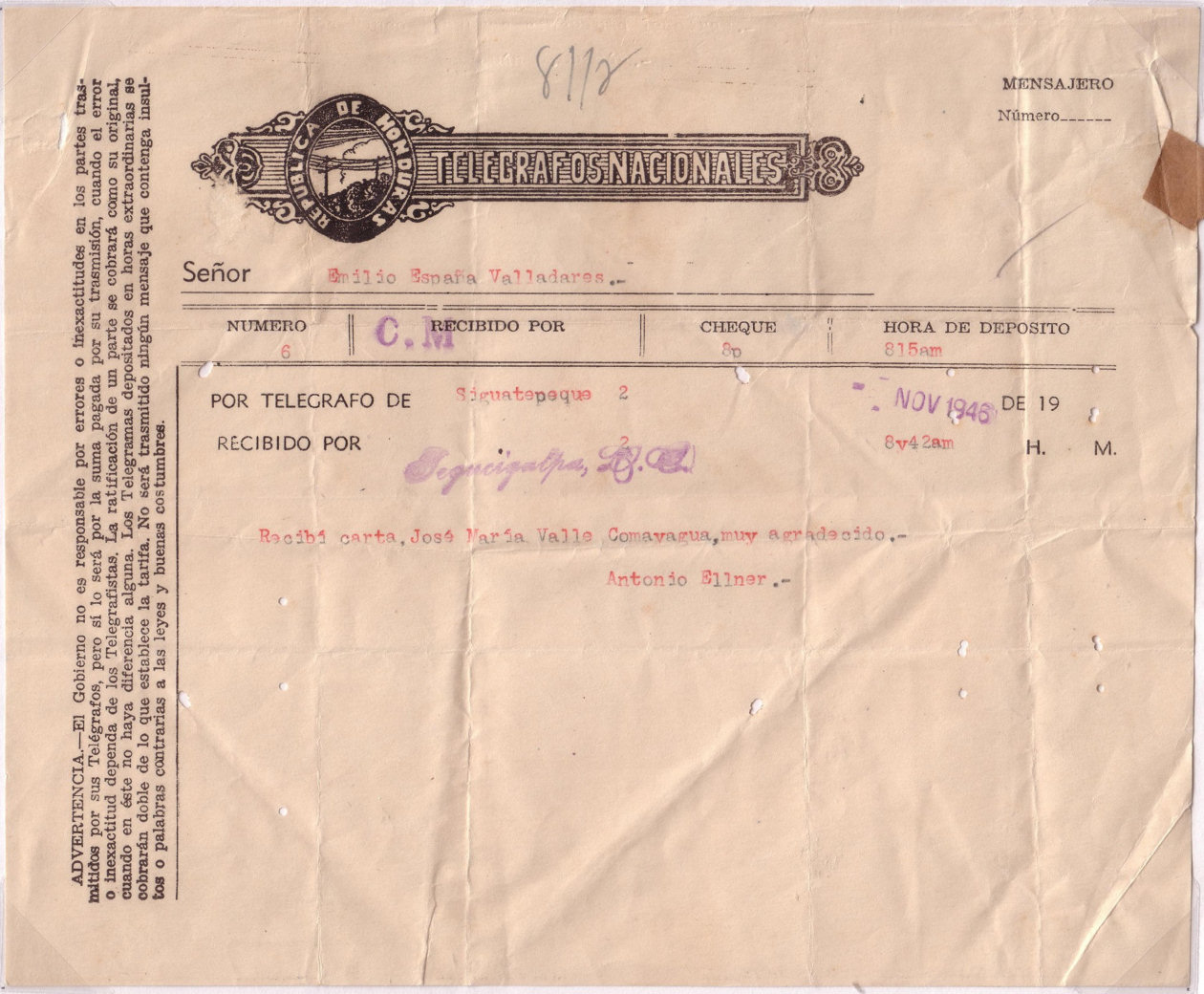
A Telegram of November 1946 received at Siguatepeque, between San Pedro Sula and Tegucigalpa, from Comayagua, both in El Paraiso.
Image courtesy of Rolf Lamprecht.
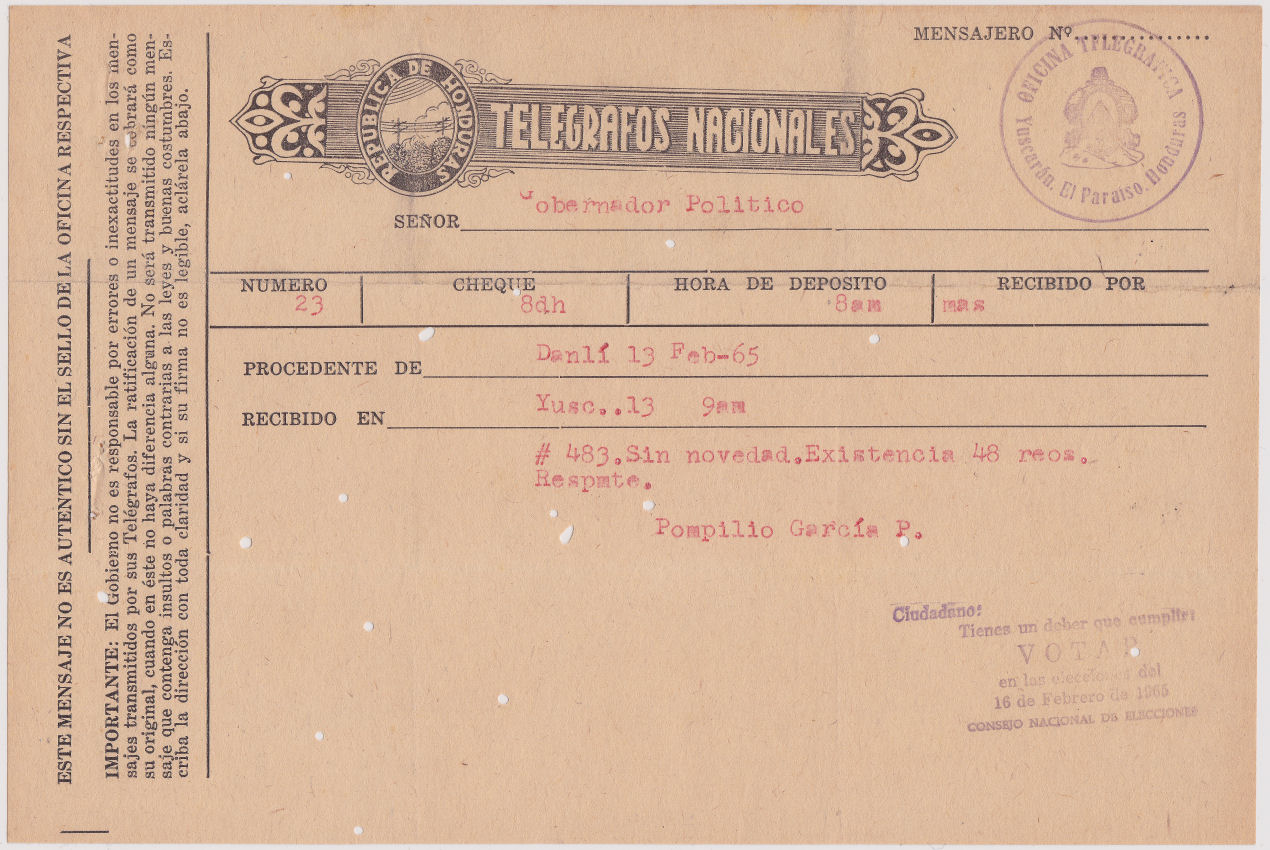
A Telegram of 13 February 1965 received at Yuscarán from Danlí, both in El Paraiso.
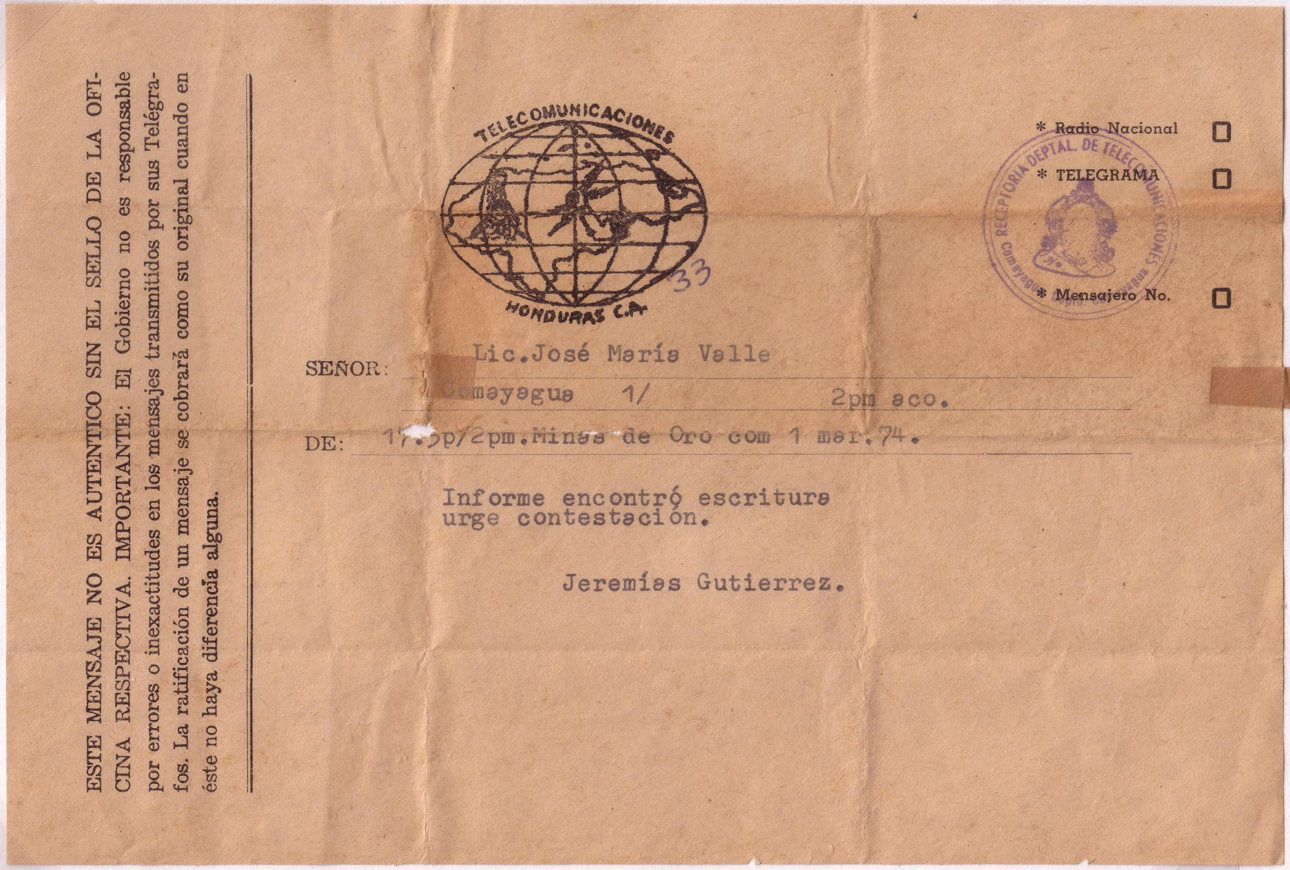
A Telegram of 1 March 1974 received at Comayagua, west-central Honduras. Image courtesy of Rolf Lamprecht.
An interesting (and relevant) envelope from Juan Doborow, Tegucigalpa, Honduras to The Bayer Co., Export Department, NY.
Courtesy of Stephen Roche of LatinAmericanPhilatelics.com
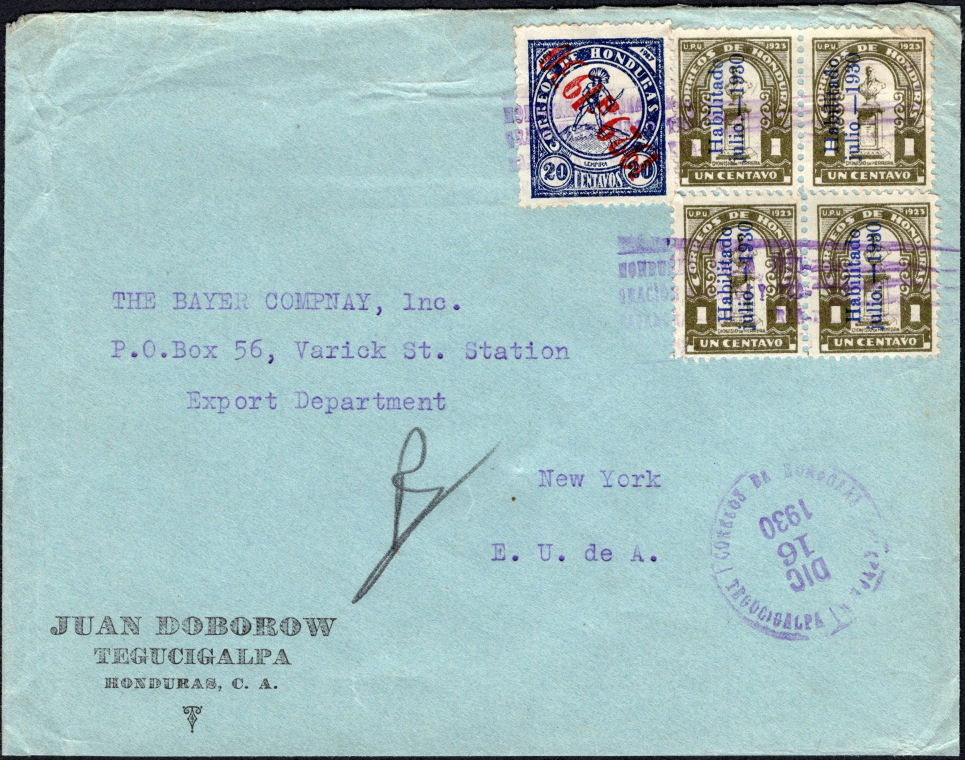 |
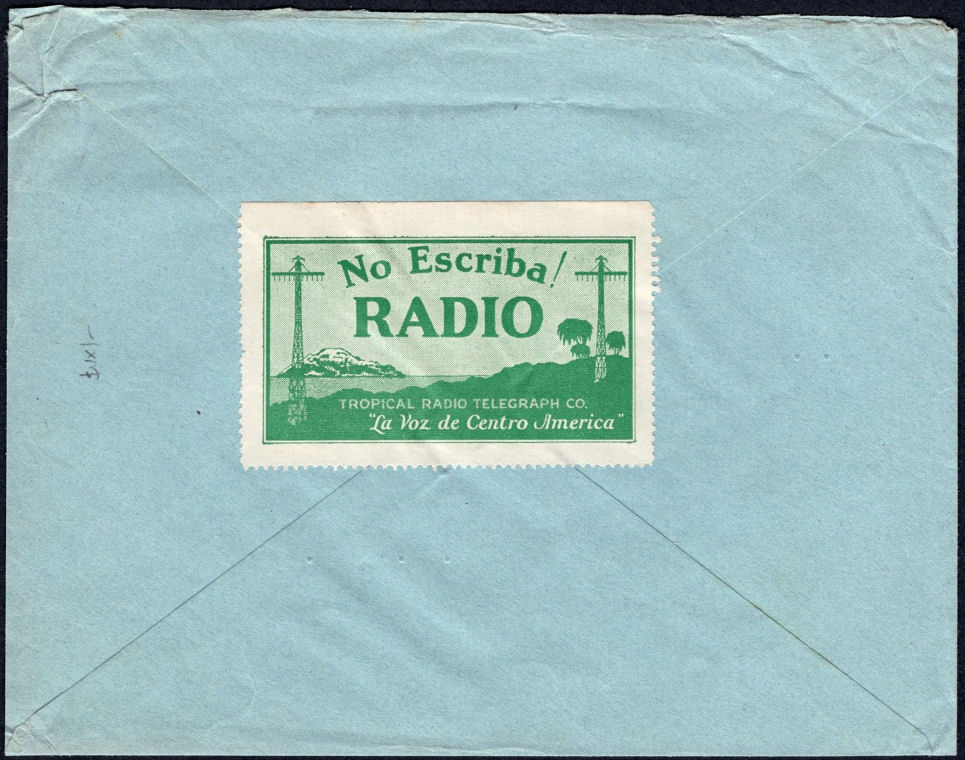 |
| The front has 24c in stamps and is dated 16 December 1930 with a Tegucigalpa C.D.S (for some reason) | The back is strangely lacking a U.S. backstamp, but does bear a seal/label saying (in Spanish) : Don't write! / RADIO / Tropical Radio Telegraph Co / "The voice of Central America" |
The franks of Tropical Radio have "The voice of the Americas", so there may be similar items for South America.
Tropical Radio was a wholy-owned subsidiary of the United Fruit Company that specialized in importing fruit from "the Americas".
Similar labels/seals were no doubt used in many countries, wherever they operated. The US company probably thought of them as advertising stickers, though countries
more familiar with telegram seals probably used them as such. Having said that, I don't know of other seals used in Honduras or even countries surrounding it.
So was Juan after some "pesticide" ?
I'm guessing there was no U.S. backstamp because this was actually sent by radio.
Is that a pencilled "R" on the front ?
This is only a guess though. The 24c postage rate is quite high.
Stephen Roche tells me that the registered surface mail rate to the USA in 1930 was 16c,
so certainly there is a bit of a mystery as to what exactly happened.
If you have further information, please get in contact.
